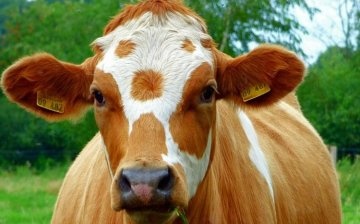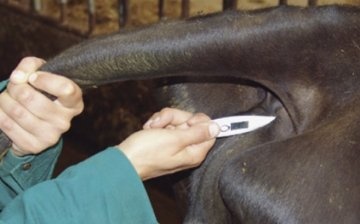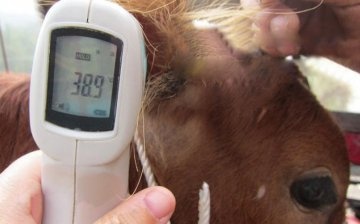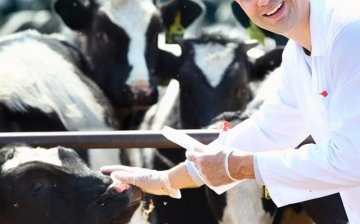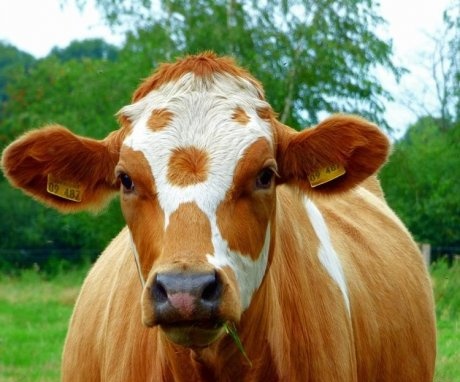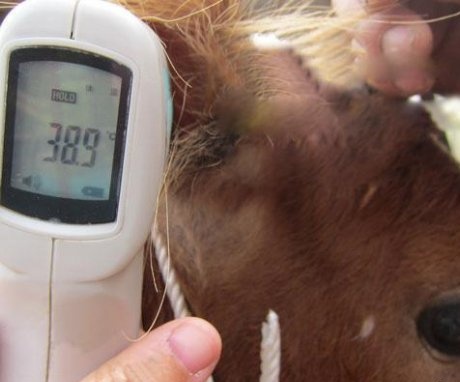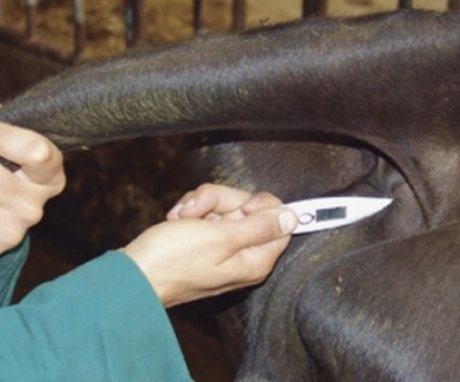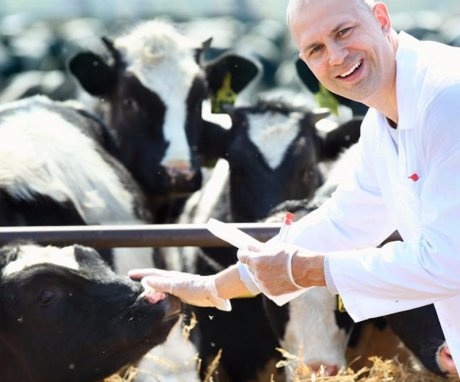What body temperature should a cow have and how to measure it correctly
Body temperature is an important diagnostic indicator by which you can determine the condition of the animal and identify the disease in the early stages. It is necessary to find out how the body temperature of a cow is measured correctly in order to obtain reliable diagnostic results.
Normal cow temperature
Cows are warm-blooded animals. One of their main features is that their body temperature is constantly maintained within a certain range.
The normal range for cows is 37.5 - 39.0 degrees. This temperature is determined by the rate of metabolic processes in the body. It is important to understand that the deviation of the indicator from the norms is not always a sign of pathology. In some cases, the actual body temperature is abnormal even if the animal is completely healthy.
Possible reasons:
- introduction of new feeds, additives into the daily diet;
- load on the body when transporting an animal;
- individual characteristics characteristic of a particular breed;
- violation of the walking regime;
- age-related changes.
In some cows, a high or low temperature can be an individual feature of the body. This can be confirmed by a veterinarian who, normally, should check the animal regularly.
Calf body temperature
The normal reading for young cows is different from that for adult cows. Calves up to 2 weeks of age have a slightly higher body temperature. Normally, it should be from 38.5 to 40.0 degrees. In calves under 1 year old, the indicator ranges from 38.5 to 39.5.
Why is rising
A disorder accompanied by an increase in body temperature and overheating of the body is called hyperthermia. The deviation can be caused by numerous diseases.
The most common reasons are:
- Food poisoning. The body of cattle is sensitive to toxic substances that can enter the stomach with feed. A common cause of poisoning is eating rotten hay, low-quality root crops and other plant products.
- Violation of the diet. A rise in temperature can be provoked by the constant use of mineral supplements, feeds containing hormones and other harmful substances. Typically, such components are contained in compositions aimed at increasing the body weight of the animal. Violation of the diet is often accompanied by diarrhea, vomiting, lack of appetite in cows.
- Complications after childbirth. Cows that have recently calved often develop complications. The rise in temperature is usually attributed to trauma to the birth canal and the subsequent inflammatory process. Sometimes in cows, the placenta is retained, which causes infectious tissue damage.
- Mastitis. Disease of the mammary glands, characteristic of dairy cows. Pathology is accompanied by a local inflammatory process, against the background of which the body temperature rises. Usually caused by streptococcal and staphylococcal infections.
- Infection with worms. Pathology is accompanied by an increase in temperature, regular constipation or diarrhea. Cows have a cough, their body weight decreases.The volume of milk yield decreases and the taste of milk does not correspond to the norm.
Such reasons are more common than others. They usually develop due to improper care of the animal. An increase in temperature can also be observed with other, more serious pathologies.
Among them:
- cattle plague;
- pneumonia;
- leukemia;
- brucillosis;
- mad cow disease;
- cystitis;
- anthrax;
- foot and mouth disease;
- tetanus.
A fever in a cow may indicate a variety of diseases. The identification of such a symptom indicates the need for urgent veterinary care.
What is the danger of pathology
An increase in the body temperature of a cow does not in all cases indicate a direct threat to life or health. Many diseases are successfully treated and the animal recovers. But some pathologies do not lend themselves to full therapy, which leads to the death of livestock.
The most dangerous are anthrax, foot and mouth disease and brucillosis. These diseases quickly spread among cows and bulls, can provoke an epidemic and the loss of all livestock. In addition, such diseases pose a threat to humans.
Associated symptoms:
- body temperature - 40-41 degrees;
- rapid breathing;
- muscle tremors, cramps;
- lack of appetite in the animal;
- cessation of lactation;
- constipation, diarrhea, sometimes with blood;
- swelling in the pharynx, neck;
- lethargy of movements, drowsiness.
When such manifestations appear, the animal should be separated from the herd. You need to contact your veterinarian. A mandatory requirement is the collection of tests to determine the cause of the onset of symptoms.
How are measurements taken
Some breeders make the mistake of trying to sense a cow's body temperature by touch.
The tactile method is impractical, since metabolic processes in the body of cattle are not the same as in humans. To correctly measure, you must strictly follow the instructions.
What thermometer is used
For cows, you can use a regular home thermometer, which is used to measure the temperature of a person. Experienced breeders advise using an electronic thermometer. Such a device is more reliable, does not break and has more compact dimensions. As a result, the cow experiences less discomfort and anxiety during the procedure.
The use of obsolete mercury thermometers is not recommended. If damaged, the cow can be poisoned by heavy metal fumes.
At large livestock enterprises and farms, it is recommended to use special veterinary thermometers. They are easy to use, safe, and their results are highly reliable.
Instructions for taking measurements
It is recommended to wear work clothes before the procedure. Hands must be thoroughly washed and protective gloves must be worn. This is to prevent infection of the animal through a non-sterile instrument. It will also protect the person from infection that the cow might be infected with.
How is the procedure carried out:
- The thermometer is treated with an antiseptic agent with alcohol.
- Then the thermometer is thoroughly lubricated with petroleum jelly.
- The cow's tail is lifted.
- The thermometer is inserted into the anus.
- Hold the thermometer for 6-7 minutes.
- The device is removed, readings are taken.
When taking measurements, it is important to observe precautions. The animal may kick with its hind hooves or start butting.
Another difficulty that can be encountered when taking measurements is the involuntary defecation of the animal. To prevent this, you can give the cow a laxative and take her temperature with a rectal thermometer after she has had a bowel movement.
After the procedure, the anus of the cow should be wiped with an antiseptic. Similar manipulations are carried out with a thermometer. It should be thoroughly rinsed under running water, after which the tip should be soaked in an alcohol solution.
What to do if the temperature is above normal
An excess of the indicator by 0.5-1 degrees is not regarded as a clear sign of pathology. An exception is when cows show additional symptoms of the disease.
More often, fever in cattle is diagnosed with a deviation from the norm by 1.5-2 degrees. In these cases, veterinary assistance is required.
How to shoot down
You can take any therapeutic measures only after the veterinarian has established an accurate diagnosis. Otherwise, the treatment will be ineffective. Therapy involves an integrated approach. The main way to stabilize the temperature is to take medication.
The following groups of drugs are used:
- antibacterial, antifungal;
- anti-inflammatory;
- hormonal;
- antiparasitic.
Medicines are administered to cows by intramuscular injection. Less commonly, the drug is given with food or drink. The most common preparations for cows are Polyflex and Antipyrine.
Animals with fever are shown to have a plentiful drinking regime. A gentle diet is also recommended. The diet should include food enriched with vitamins and microelements.
Cows showing signs of illness should be checked daily for 10-15 days. You also need to regularly measure the temperature of the animals after calving. The results are logged so that changes can be tracked.
Some illnesses accompanied by high fever do not respond to treatment. To eliminate the risk of spreading the infection, the animal is slaughtered and disposed of.
If the temperature is too low
Cow hypothermia is considered relatively rare. But such a condition can also indicate pathologies that are potentially dangerous to health and life.
In what cases the temperature can drop:
- with severe hypothermia;
- in case of poisoning;
- against the background of hormonal disorders;
- due to improper milking of the cow.
The body temperature of cattle is increased by external heating of the animal. The cow should be transferred to an insulated room. Use heating pads, blankets, warm bedding. Warming compresses are applied, which are placed on the neck and back of the animal.
With hypothermia and a drop in body temperature, an abundant warm drink is indicated. If the condition of the cow is serious, the temperature is raised with medications.
Measurements are carried out 3-4 times a day until the onset of persistent improvement. In the future, the temperature is measured 1-2 times a day for 2-3 weeks in order to exclude the risk of re-development of pathology.
Preventive measures
Cattle need careful grooming. Otherwise, the risk of illness associated with high fever increases significantly.
Basic preventive recommendations:
- Timely disinfection of barns, replacement of bedding, removal of manure.
- Combating dampness and stagnant air inside the cows' house.
- Regular checks by representatives of the veterinary service, sampling of tests.
- Complete and balanced nutrition.
- Competent preparation of cows for calving.
- Prophylactic vaccination of cattle and other domestic animals.
- Compliance with the technology of grazing cows in the spring-autumn period.
- Compliance with sanitary standards during milking.
- The fight against worms in cattle.
- Prevention of injuries and other mechanical injuries in animals.
- Introducing vitamin and mineral supplements into the diet.
- Regular cleaning of animal hair from dirt and manure, sanitizing the udder.
To prevent disease, it is imperative to maintain suitable conditions for keeping cattle. Each cow needs at least 4 square meters. m indoors. If livestock are housed in stalls, the distance between each head should be at least 1 m.
There must be adequate ventilation inside the room. At the same time, a cold draft in the barn is unacceptable, since cattle are sensitive to it. Each cow should have a place to rest and sleep with soft hay or straw bedding.
Sick animals must be kept separately from healthy ones. It is best if the cows with the temperature are transferred to a separate room, where they will be isolated. This will prevent the risk of contamination of the livestock and associated losses.
The temperature of a cow is a physiological indicator that indicates the general condition of the animal. Excessive temperature is a symptom of numerous diseases, including those that pose a potential danger to the entire livestock. Measurements must be carried out using a working disinfected thermometer in strict accordance with the instructions. The method of treatment is determined based on the specificity of the diagnosed disease.
Watch a video about the most common cow diseases, their symptoms and treatment methods:



